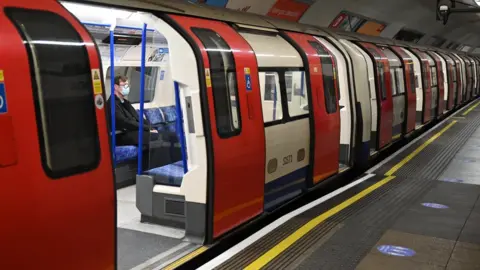Coronavirus: Will London embrace walking and cycling?

The fabric of cities looks set to radically change as the pandemic lockdown eases.
The challenge for the authorities is that cities are built on moving a high density of people very quickly.
There were four million Tube journeys a day before the lockdown, now it has dropped to 200,000. There were even more bus journeys at 5.5 million, falling now to about a million journeys a day.
People could live in one area and could very easily socialise or work in another 10 miles (16.1 km) away.
 NEIL HALL
NEIL HALLNow those transport systems will only be able to deal with 15% of what they used to.
Home working and staggered start times could certainly help but the fear is many will get into cars and cause gridlock.
According to Transport for London (TfL), prior to lockdown there were 4.6 million car trips on an average day and 1.4 million car passenger trips. Many of them were for short journeys:
- 14% were under 1km (0.6 miles)
- 21% were 1-2km (0.6-1.2 miles)
- 15% were 2-3km (1.2-1.7 miles)
- 10% were 3-4km (1.7-2.5 miles)
- 7% were 4-5km (2.5-3.1 miles)
- 33% were over 5km (3.1 miles)
So could one solution be what mayors have been trying to get more of us to do for years, especially those shorter journeys? Is this the moment when active travel - walking and cycling - returns in considerable numbers?
 Reuters
ReutersThe mayor's existing transport strategy is to get 80% of all journeys to be made by public transport, walking or cycling by 2041.
Cycling seems to be increasing quickly in London with reports from some bike shops of an 80% increase in sales.
Certainly with fears around maintaining social distance on the Tube, trains and buses, bikes can look like an attractive travel option.
They are also a good form of exercise and they are clean, quick and relatively inexpensive.
 PA Media
PA MediaIn other cities like New York and Paris they are pushing cycling as an alternative to the motor vehicle.
New York is creating 110 miles (177 miles) of bike lanes. In Germany new laws means it is illegal to overtake a cyclists on narrow lanes and illegal to park in cycle lanes.
So where is London?
Danny Williams, an influential cycling campaigner, believes so far London is lagging behind. He thinks people will stay local and bike lanes are a good way to provide extra reassurance and safety for new cyclists as well as providing social distancing.
But Dr Rachel Aldred, from the University of Westminster, warns there is only a small window of opportunity for cycling to establish itself on the streets before motor vehicles return.
Certainly to get big changes, cycling needs to as be seen as safe, easy and practical. And no longer an outlier.
And any move to reallocate road space to cycling and walking will attract a backlash from some motorists.

- A SIMPLE GUIDE: How do I protect myself?
- AVOIDING CONTACT: The rules on self-isolation and exercise
- HOPE AND LOSS: Your coronavirus stories
- LOOK-UP TOOL: Check cases in your area
- TESTING: Can I get tested for coronavirus?

City Hall says they are working on a plan for temporary bike lanes. The lanes will probably be lines of cones and signs on busy cycling routes, which campaigners will hope link into a useable network.
We expect more detail this week but the mayor has indicated it will be low cost. He says London wants to provide cycling infrastructure that will provide a sea change.
Supporters also firmly believe cycling and walking could offer part of the answer to London's transport problem.
